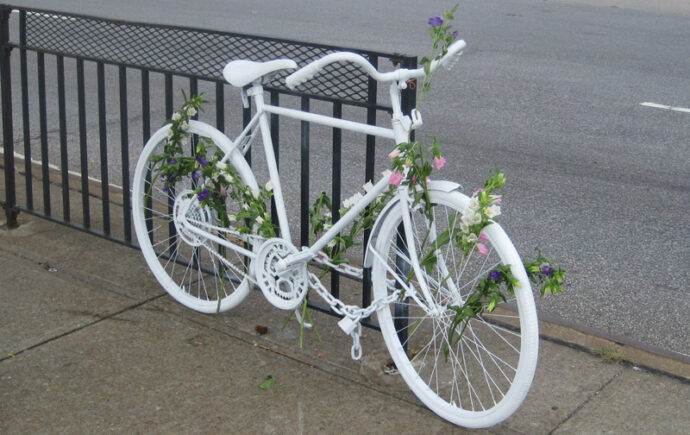By now you’ve probably seen the mug shot of Episcopal Bishop Heather Cook on the day she was booked for manslaughter stemming from a hit-and-run DUI. In press reports the mug shot generally runs alongside another photo: sometimes a close-up of a bespectacled middle-aged blonde woman, with a clerical collar and dangling earrings framing a wide face and a gap-toothed smile. Another of Cook on the day she was consecrated as a bishop, standing and smiling with friends, miter atop her head and shepherd’s crook in hand. And then there’s the unfortunate image of Cook standing behind an altar, blessing a dozen cruets of wine.
On the Saturday after Christmas, the second ranking bishop of the Episcopal Diocese of Maryland was said to be drunk and texting when she steered her Subaru into the bike lane and plowed into Tom Palmero, an avid cyclist, husband, and father of two. With the passenger side of her car’s windshield shattered by the force of the accident, Cook drove on. Another cyclist caught up to the Bishop’s car at a stoplight and rapped on the window. Cook stepped on the gas and disappeared into her gated apartment community.
After calling a diocesan official, Cook returned to the scene, some 20 to 40 minutes later. And by then, Palermo was dead. The bishop wasn’t charged until days later, after an extensive police investigation and a social media campaign demanding her prosecution. A local media upstart, the Baltimore Brew, has pursued the story aggressively, outpacing in both the scope and depth of coverage the more staid Baltimore Sun.
The Bishop turned herself in on January 9th, and a tough judge set bail at an exceptionally high $2.5 million, noting Cook’s “indifference to life” and calling her a flight risk. A few days later, a defrocked priest, described as Cook’s “steady companion,” stepped forward with the cash and promissory note to free Cook. In the days since, the Bishop reportedly has returned to rehab on the shores of Chesapeake Bay, where she stayed in the days before she was booked. Cook is a suspended bishop now, and Episcopal Church officials have begun disciplinary procedures that will probably lead to her firing.
Is the Episcopal Church itself on trial, right alongside Bishop Cook? It sure seems that way.
One of the story’s inevitable themes is the charge of church leaders’ hypocrisy and ineptitude, a charge sounded even (especially?) by those inside the church itself. “I’d like to know how you can get our trust back, because right now it doesn’t exist,” one Episcopalian asked Cook’s boss, Maryland Bishop Eugene Taylor Sutton, at a parish meeting in Lutherville. The parishioner’s concerns are understandable. Where’s the accountability? Hadn’t anyone seen this coming? Why hadn’t a pastor, another bishop, stepped forward to intervene? Why were voting delegates to Maryland’s diocesan convention kept in the dark about Cook’s 2010 arrest on DUI charges?
Some church officials, presumably Sutton and the committee that nominated Cook, knew about Cook’s earlier arrest. The details are tawdry: Cook was stopped because her car was clunking along on a tire so flat its rubber was stripped to the rim. Cook had vomit on her blouse and reeked of alcohol. The arresting officer found a liquor bottle and a stash of marijuana, and Cook wobbled so much during a field sobriety test that the cop cut it short. She was arrested but never did time, nor, apparently, was she remanded to rehab.
As if to underscore the yawning gap between the Bishop’s public face and the realities of her private life, the Baltimore Sun featured a YouTube video of a sermon Cook preached months ago to a sparsely attended Sunday morning service. The Bishop spoke in words that now seem pathetic as well as chillingly prophetic: “Things happen suddenly, and we’re either prepared in the moment or we’re not, and we face the consequences. We can’t go back. We can’t do it over” (7:07).
There’s another, more pointedly political angle to this story: the case of Bishop Cook has become a meme in the ideological warfare waged by right-wing Anglicans against the Episcopal Church, including a breakaway denomination called the Anglican Church in North America [ACNA], and groups like the American Anglican Council.
For decades, right wing Anglicans in the U.S. and elsewhere have blamed the Episcopal Church’s precipitous slide in membership on its captivity to liberalism and liberation theology, and especially to the “agendas” of sexual dissidents and radical women. There’s no credible evidence linking the Church’s alarming stats to its embrace of liberal policies, but that hasn’t stopped the right from relentlessly hammering the claim.
The most spectacular flare-ups in this war have also been about bishops: the consecration of the Episcopal Church’s first openly gay bishop, Gene Robinson, in 2004, and the election of Katharine Jefferts Schori to a 9-year term as the Church’s Presiding Bishop in 2006, the first woman to hold that post. Both Robinson and Jefferts Schori have been subjected to withering attacks from the right–Robinson because of his sexuality, and Jefferts Schori for her support for same-sex unions and for her aggressive handling of property disputes with breakaway dioceses and parishes. And of course because she’s a woman.
The right has folded the story of vehicular manslaughter into this narrative of left-wing captivity and declension–sometimes subtly, at other times blatantly. The Christian Post, a conservative evangelical on-line news site that claims non-alignment but leans heavily right, has given the story heavy coverage. In one of its articles CP linked Cook to Gene Robinson and to other Episcopal Bishops–including a dead one–with alcohol problems. (Robinson went to rehab during his episcopacy). An editorial that ran on the website of the American Anglican Council called the incident “[s]ad for the Episcopal Church that has fallen so far away from godly discipline and order.”
The right-wing Anglican blogosphere was more direct: “The most recent outrage (and there have been many) of a drunken bishop killing a cyclist, then fleeing the scene of the crime and hiding behind a gated community so she wouldn’t have to face her accusers is just the ass end of a long line of episcopal outrage and filth dating back more than 40 years. In the case of Bishop Suffragan Heather Cook, a half empty whisky bottle and a marijuana bong have become her own personal Eucharist,” thundered David Virtue of virtueonline.org, who concluded, “This latest outrage will only hasten the church’s demise.”
Many, though not all, of these Anglicans reject any role for women as priests or bishops. And so for them, Heather Cook’s crime spree began with her ordination, and continued because the church that consecrated her was terminally ill.
Follow Jesus into the neighborhood; travel lightly.
While there are points of life and light in the Episcopal Church, as in any other old-line denomination, right-wing detractors are correct in noting that the numbers are grim and the future far from bright. The question is, why? Why has this once-powerful church, with unmatched cultural capital and an impressive treasury, become so anemic? The answer is surely more complicated than the simple right-wing Anglican formula that liberalism = death.
But let’s face it: this has been a tough few months for the Episcopal Church, and the Cook case must feel like a punch in the gut. Take the case of the denomination’s seminaries, so many of which are struggling. The Episcopal Divinity School in Cambridge almost imploded last spring after a showdown that pitted faculty against an unpopular dean and the trustees who supported her. General Theological Seminary in New York City, once known as a finishing school for future bishops, was engulfed in a similar but even more public battle in the fall of 2014 after struggling financially for years.
While sideshows like these play on in the background, the Episcopal Church continues to hemorrhage members. No wonder Jefferts Schori said thanks but no thanks to a second term as Presiding Bishop. Who would blame her?
In the run-up to the Church’s triennial convention in Salt Lake City in June of 2015, the Task Force for Reimagining the Episcopal Church (TREC) has developed a restructuring plan to streamline the Church’s considerable bureaucracy, eliminating most standing committees and commissions, lowering the goal for diocesan assessments to more realistic levels for the support of the national church, and vesting more power in the office of the Presiding Bishop, who will take on more of a CEO role.
Will TREC, whose sacred slogan is, “Follow Jesus into the neighborhood; travel lightly,” fix what’s wrong with the Episcopal Church? Only time will tell. But how possible will it be for the Church to travel lightly when it’s so weighed down by its own cultural baggage, including its very brand? It’s not just the media that’s to blame for the relentless spotlight on the Church’s bishops; it’s also how the church puts itself forward.
The visibility of both Bishop Cook and the larger Episcopal Church in this sad and outrageous story of vehicular homicide says something about the denomination’s core identity. After all, this is the church with bishop in its very name, so is it any wonder that its bishops become conflated with the denomination and its mission–sometimes for good, sometimes for bad, and this time for worse? I’d guess not many people pay attention to the theological rationale for having bishops, or even less to the mechanics of consecrating them, but one fact remains: the Episcopal Church’s brand is inseparably linked to its bishops, and that can be a liability, as this case demonstrates so dramatically.
But at the end of the day, the story is not about church politics, not about the survival of another punch-drunk old-line denomination. The story that matters most is Tom Palermo, who leaves behind a grieving widow and two young children. That’s the point made by those, including many sorrowful Episcopalians, who’ve given to a fund set up for Palermo’s children. It’s also a point made by Baltimore cyclists on New Year’s Day, during a memorial ride that drew 1500 bikers. Fittingly enough, the ride began in the parking lot of Baltimore’s Episcopal Cathedral of the Incarnation, and made its way to the place where Palermo was struck, now a roadside altar with a ghost bike marking the spot.
Correction: Maryland Bishop Eugene Taylor Sutton was initially identified as Eugene Sutton Taylor. RD regrets the error.





